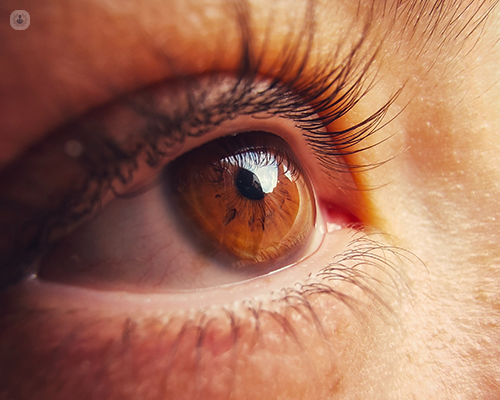Full-thickness macular hole surgery and care
Autore:A macular hole affects 1 in 500 people and can cause distorted vision and blind spots. Professor James Bainbridge, an internationally renowned ophthalmologist, provides you with a comprehensive overview of the condition, causes, symptoms, surgery (its main form of treatment), post-surgery care and the expected results.

What is macular hole?
A macular hole is a small hole in the centre of the retina. The retina is the sheet of light-sensitive nerves in the eye, like the film in a camera. Its central spot, the ‘macula’, is particularly sensitive and is responsible for the sight needed to read, recognise faces and drive safely. Even a tiny hole in the macula can impair eyesight.
How common is a macular hole?
A macular hole affects approximately 1 in 500 people. It typically affects older people and generally, it affects women more than men. Usually, only one eye is affected but a minority of people with the condition, about 1 in 6, can have their second eye affected.
What causes macular hole?
A macular hole typically develops when normal ageing causes changes to the vitreous gel, causing it to separate from the retina. This process of separation, also called ‘posterior vitreous detachment’ (PVD), is usually harmless but can occasionally cause a hole in the macula. A macular hole can also be caused by high myopia, physical trauma or inflammation in the eye. Macular holes typically involve the full-thickness of the retina. Partial-thickness macular holes are less common and generally cause less harm to sight.
How does macular hole harm eyesight?
Many people with macular hole experience distortion, blurring or a blind spot affecting the sight of the affected eye. Some people may become aware of impaired eyesight only when their unaffected healthy eye is covered, or when the condition is identified by an optometrist or healthcare professional.
What is the natural outcome of macular hole?
Up to 1 in 10 small macular holes heal naturally but most macular holes cause progressively severe impairment of central sight. Macular holes do not typically affect peripheral eyesight (what you can see from the side while looking directly forward), which is normally preserved.
What are the likely benefits of surgery for macular hole?
Surgery offers a 90% likelihood of repairing the hole and protecting sight. Some persistent disturbance of sight must be expected but 75% of people benefit with gradual improvement of sight. Surgery improves sight in 15 of 20 people and protects sight from getting worse in 4 of 20 people.
The outcome can be particularly favourable when surgery is performed sooner rather than later. Eyesight typically improves progressively over a period of months and can continue to improve even up to a year after surgery.
What if the surgery does not repair the hole?
In the unlikely event that the macular hole remains open, further surgery can be considered.
What are the risks of surgery?
Vitrectomy surgery can alter the focus of the operated eye. This is usually addressed after recovery with the guidance of an optometrist to update any spectacle correction.
Vitrectomy surgery predictably causes progressive cataract (clouding of the eye’s natural lens) within two years. Cataract typically results in progressive myopia (short sight), glare and clouding of vision, but can be managed by surgery to replace the clouded natural lens with a clear lens implant. This procedure offers the opportunity to correct for pre-existing refractive error including short-sightedness, long-sightedness and astigmatism.
All surgery inside the eye carries a risk of harm from side effects, including:
- raised eye pressure
- inflammation
- detached retina (1 in 100)
- bleeding
- infection (1 in 1000)
These effects can usually be managed effectively using medication or further surgery. Furthermore, the risk of lasting harm to sight, comfort or cosmesis (aesthetic appearance) despite further treatment is up to 5% (1 in 20).
Is any other treatment available?
Small macular holes may benefit from an injection into the eye that consists of ocriplasmin, an enzyme designed to release the vitreous gel from the retina by chemical means. This injection has a success rate of 40% but can cause side effects including floaters and disordered colour vision. No other medication or eye drop is able to help.
What does surgery for macular hole involve?
The surgery is comfortably performed as a day-case procedure using local anaesthetic (a numbing injection under the eye) with or without a sedative but is occasionally performed using general anaesthesia.
The eyelids are gently cleaned and the face is covered by a sterile sheet. Only lights and shadows may be seen. The eye is held comfortably open using a clip so that no effort is needed to keep the eye open or still.
Keyhole microsurgery is performed inside the eye, clearing the vitreous gel (‘vitrectomy’ surgery) to protect the retina against harmful traction. A bubble of gas is introduced to provide a surface against which the hole can heal and then tiny dissolvable stitches may be used to close the keyhole incisions. The operation takes up to an hour to complete and an eye pad and shield are applied for protection overnight.
Will I need to position face-down after surgery?
Some people are advised to maintain a face-down position for a period following surgery to improve the outcome by maintaining consistent contact of the floating gas bubble with the macular hole. Although face-down positioning might improve the outcome for larger macular holes, most can be successfully repaired without any need for uncomfortable positioning.
What should I expect following the operation?
Predictable temporary side effects of the local anaesthetic can persist for up to two days. These include
- numbness around the face and forehead
- drooping of the eyelid
- blurred vision
- double vision
- squint
Mild discomfort and redness of the eye are common at first (and can persist for a few weeks around any dissolving stitches). Simple analgesia (pain relief) may be used for comfort, but pain is not expected. Eye drops are provided to promote rapid recovery.
The gas bubble in the operated eye temporarily obscures its sight as if looking underwater but vision typically improves day by day as the gas is naturally absorbed. The edge of the gas bubble may be apparent at first as a dark line across the upper field of view, its appearance varies with the position of gaze. As the gas bubble gets smaller, it may become evident as a dark circle that progressively sinks into the lower field of view. Smaller additional bubbles may become apparent before the gas disappears completely.
How should I care for my eye after surgery?
Try to avoid lying face-up for one week after surgery because when the eye is gazing vertically upwards, the gas bubble will tend to float away from the macular hole. Observe any specific advice you are given on positioning.
On the morning after the operation, remove the eye shield and pad. Gently clear any discharge using clean (e.g. boiled) warm water, so that the eyelids can be comfortably separated. The shield may be discarded or cleaned for re-use during the day or night for comfort. Apply the eye drops as prescribed.
Mild discomfort is common and redness after surgery is normal even though it may appear dramatic. Use simple analgesia (e.g. paracetamol, ibuprofen) for any persistent discomfort or ache. Seek advice in the event of increasing eye pain or headache despite simple analgesia, or worsening of eyesight.
When can I resume normal activity?
Protect the operated eye from tap water for three days; washing can otherwise be performed normally. Eye make-up may be worn after seven days.
Reading, watching television and using a screen may be safely performed from the first day. The operated eye can be safely covered if its impaired sight initially interferes with the sight of the un-operated eye.
Gentle exercise such as walking can be undertaken with care from day one. More strenuous exercise such as running, cycling and swimming should be deferred until the gas bubble is fully absorbed.
Be aware that impaired vision during recovery can interfere with the ability to judge distances, particularly when navigating steps and pouring liquids.
Driving should be deferred until the gas bubble is fully absorbed and the visual standard for driving can be met.
Most people can expect to return to work within two weeks of surgery. Some people may be confident to resume work sooner.
The gas bubble typically lasts up to two weeks but, depending on the type of gas selected, can last for several weeks. Until the gas bubble has fully disappeared, travel by air (or to an elevation of 2.5 thousand feet) must not be undertaken, and general anaesthesia with nitrous oxide must not be performed.
After four to six weeks, an updated prescription for glasses or contact lenses may be advised, under the guidance of an optometrist.
Professor James Bainbridge is a specialist in the management of several conditions of the retina. Click here to see his profile and to get in touch.


